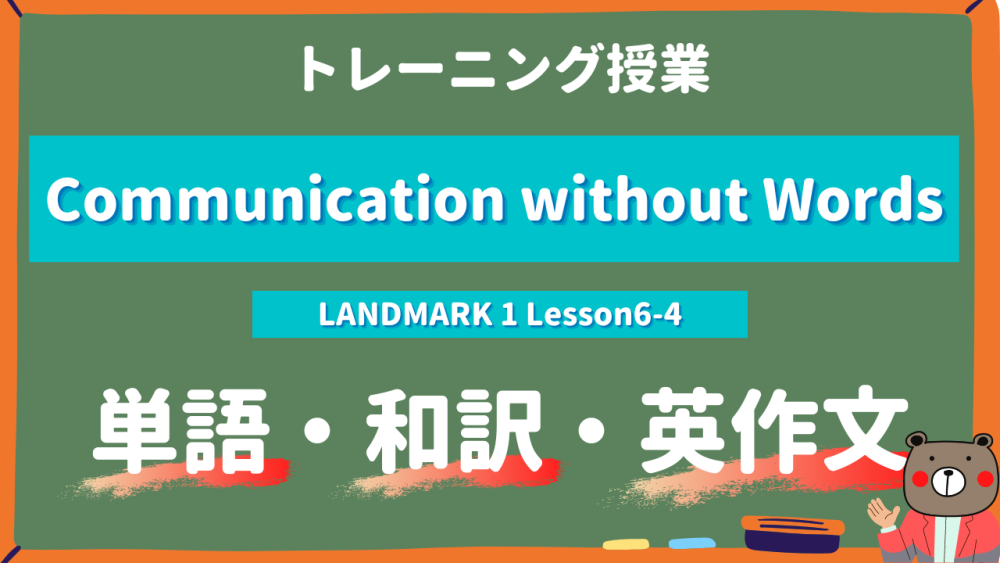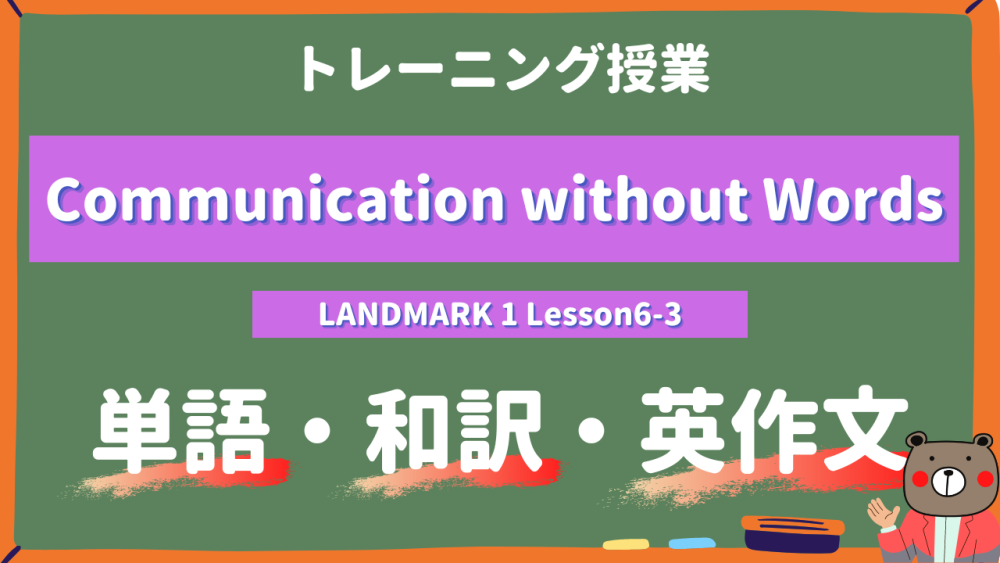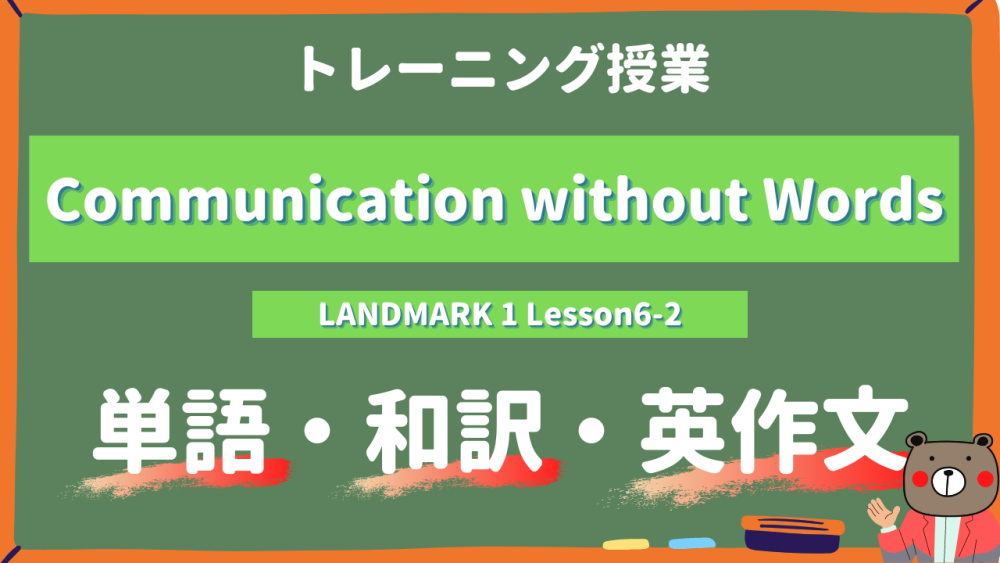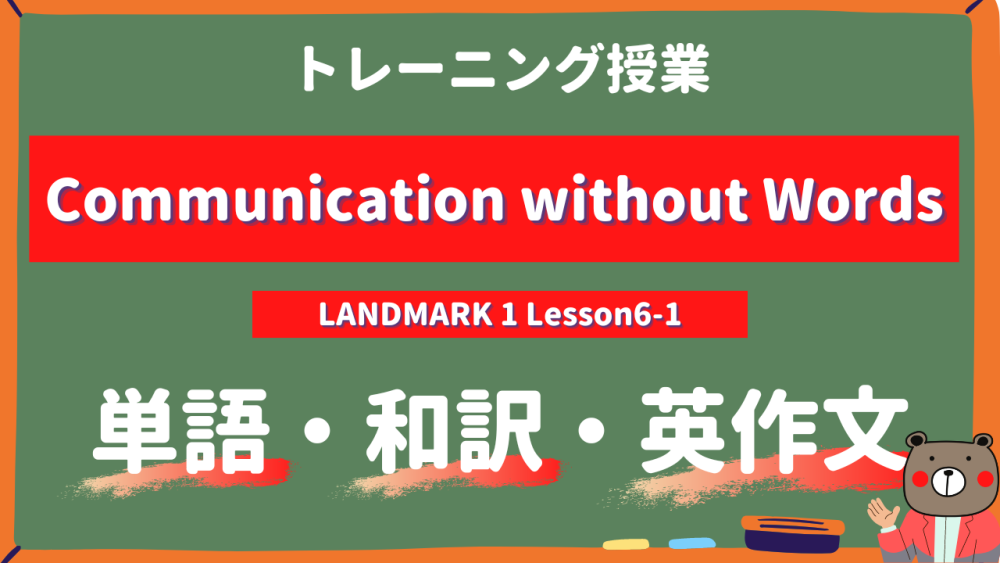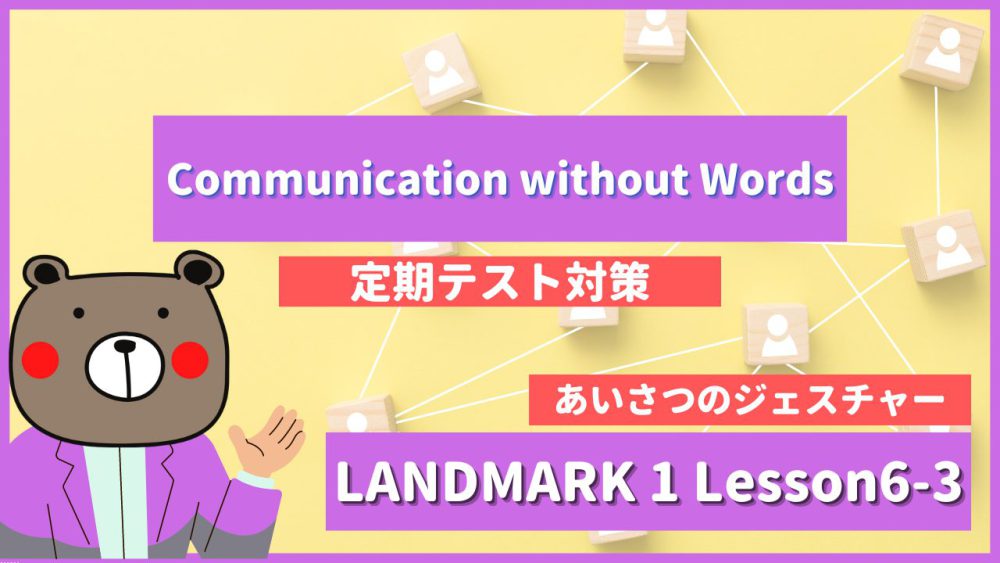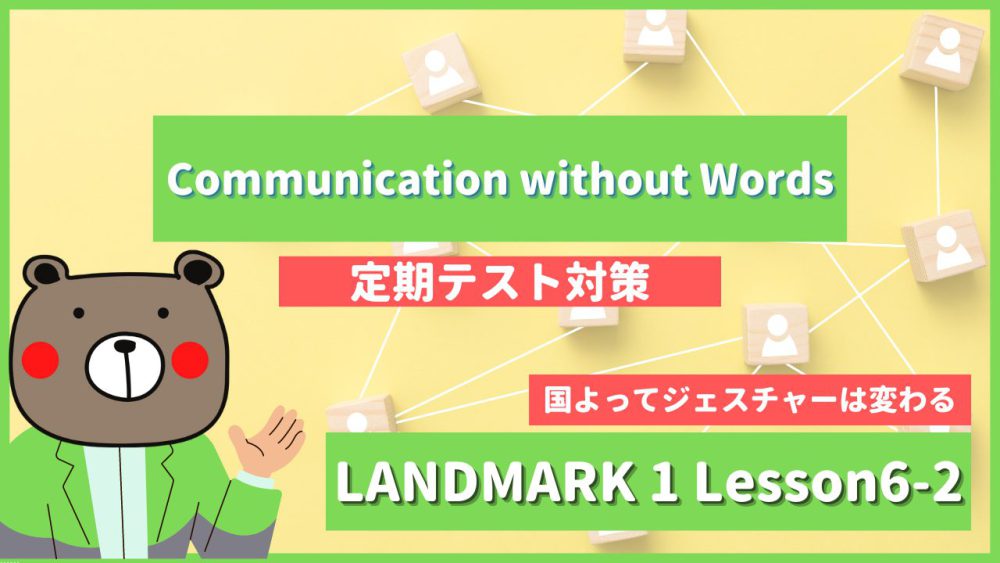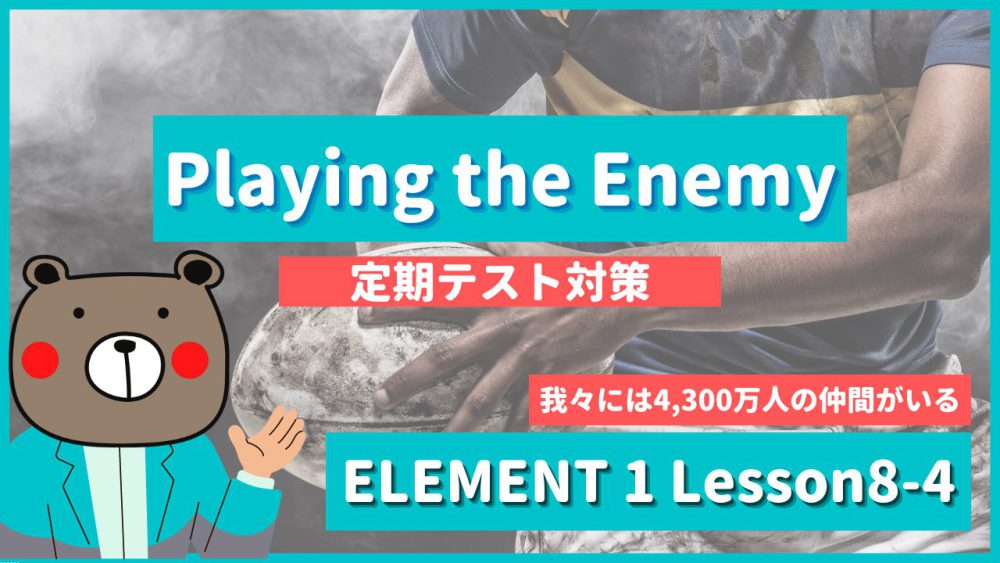▼音声で学びたい方はこちらへ🐻
現在撮影中❗️

▼LANDMARK1-高1《Lesson6》はこちらから🐻
- 授業前にひとこと
- 勉強のポイント
- 本文&和訳
- 重要単語
- 重要ポイント
- 【1】What do rakugo storytellers do to perform a character eating soba?
- 【2】What kind of tool can non-verbal communication be?
- 【3】You now know about differences in non-verbal communication.
- 【4】Let us consider how you can use non-verbal communication effectively.
- 【5】Some people use non-verbal communication consciously.
- 【6】In rakugo shows, for example, storytellers entertain their audience by telling stories using gestures and facial expressions.
- 【7】When they perform a character eating soba, they lift their folding fan up to their mouth and make a loud slurping sound.
- 【8】Such gestures help the audience understand the size, amount, or shape of an object, or the actions of characters.
- 【9】Many good speakers use non-verbal communication in presentations.
- 【10】For example, they keep eye contact with the audience while they are speaking.
- 【11】They move their eyes from person to person, or group to group.
- 【12】By doing so, the listeners may pay more attention to what the speaker is saying.
- 【13】In many cases, non-verbal communication is unconscious.
- 【14】It can cause misunderstandings because the meanings differ from place to place.
- 【15】On the other hand, it can be an effective communication tool.
- 【16】If you are aware of the importance of non-verbal communication and can use it well, you will be able to convey your thoughts and feelings more effectively to many people.
授業前にひとこと


今回は、LANDMARK1-高1《Lesson6》について扱っていきます❗️
Lesson6のタイトルは…🐻
Communication without Words
という「言葉を使わないコミュニケーション」についてのお話です。
ちなみに、このLessonでは…
冒頭の Question を踏まえて文章を読む
のを意識してください❗️
さて、いつも授業前に説明することですが…
⇧に載せてあります『単語・和訳・英作文トレーニング』をテスト1週間前から毎日やってみてください❗️曖昧な理解がなくなり、成績が爆伸びします!!
コミュ英以外の定期テスト対策は?
現代文の定期テスト対策は こちら から
古文の定期テスト対策は こちら から
漢文の定期テスト対策は こちら から
teite channel をもっと活用する


▷ 解説記事のリクエスト
▷ 新着情報のキャッチ
▷ 定期テスト予想問題
▷ オリジナルグッズの購入
ができるようになっています🐻
teite channel の 公式LINEアカウント はこちら
勉強のポイント
①本文は、効果的な非言語コミュニケーションについて、落語の噺家とプレゼンの話し手を例に説明していることを理解する。
②単語・重要ポイントをインプットする。
③冒頭の Question を踏まえて文章を読む。
本文&和訳
Question7
What do rakugo storytellers do to perform a character eating soba?
落語の噺家(落語家)は蕎麦を食べているキャラクターを演じるために何をしますか?
Question8
What kind of tool can non-verbal communication be?
どんな種類の手段が、非言語コミュニケーションになることがありますか?
本文(Part4)
【7】You now know about differences in non-verbal communication.
あなたはもう非言語コミュニケーションの違いについて知っています。
Let us consider how you can use non-verbal communication effectively.
どうやったら非言語コミュニケーションを効果的に使うことができるか、考えさせてください
【8】Some people use non-verbal communication consciously.
意識的に非言語コミュニケーションを使う人もいます。
In rakugo shows, for example, storytellers entertain their audience by telling stories using gestures and facial expressions.
例えば落語の舞台では、噺家(落語家)は身振り手振りや表情を使いながら物語を話すことによって、観衆を楽しませます。
When they perform a character eating soba, they lift their folding fan up to their mouth and make a loud slurping sound.
彼らが蕎麦を食べているキャラクターを演じるとき、扇子を口へと持ち上げ、ずるずると食べている大きい音を鳴らします。
Such gestures help the audience understand the size, amount, or shape of an object, or the actions of characters.
このような身振り手振りは、観衆がその大小、量、物の形やキャラクターの動作を理解するのを助けます。
【9】Many good speakers use non-verbal communication in presentations.
多くの良い話し手は、プレゼンで非言語コミュニケーションを使います。
For example, they keep eye contact with the audience while they are speaking.
例えば、彼らは話している間、観衆と目と目を合わすアイコンタクトをし続けています。
They move their eyes from person to person, or group to group.
彼らは、人から人へ、グループからグループへ、目線を移動します。
By doing so, the listeners may pay more attention to what the speaker is saying.
そうすることによって、聞き手は話し手が言っていることにもっと注意を払うでしょう。
【10】In many cases, non-verbal communication is unconscious.
多くの場合は、非言語コミュニケーションは無意識なものです。
It can cause misunderstandings because the meanings differ from place to place.
それは誤解を生むことがあります、なぜならその意味は場所によって意味が異なるからです。
On the other hand, it can be an effective communication tool.
一方で、それは効果的なコミュニケーションの手段になることもあります。
If you are aware of the importance of non-verbal communication and can use it well, you will be able to convey your thoughts and feelings more effectively to many people.
もしあなたが非言語コミュニケーションの重要性に気づき、それを上手に使うことができるなら、あなたは自分の考えや感情を、より効果的にたくさんの人々へ伝えることができるでしょう。
重要単語


V : 動詞 , Ving : 動名詞 , Vpp : 過去分詞, O:目的語, C:補語
| effectively | 効果的に |
| consciously | 意識して |
| storyteller | 語り手 |
| entertain | 〜を楽しませる |
| audience | 観衆 |
| facial | 顔の |
| lift | 〜を持ち上げる |
| slurp | (ずるずると)音を立てて食べる |
| object | もの、対象 |
| presentation | プレゼン、発表 |
| attention | 注意 |
| pay attention to A | Aに注意を向ける |
| unconscious | 無意識の |
| effective | 効果的な |
| aware | 意識して |
| in many cases | 多くの場合 |
| be aware of A | Aに気づいている、意識している |
重要ポイント
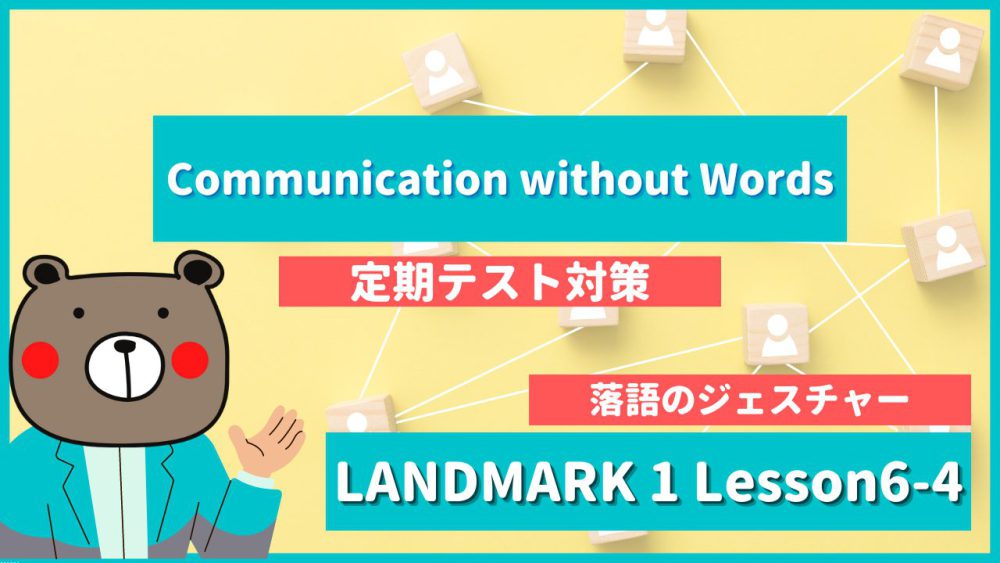

「ピンク」=重要ポイント
▼記号について
V : 動詞 Ving : 動名詞 Vpp : 過去分詞
【 】名詞句・節 〈 〉形容詞句・節 ( )副詞句・節
S:主語 O:目的語 C:補語 M:副詞
【1】What do rakugo storytellers do to perform a character eating soba?
《和訳》
落語の噺家(落語家)は蕎麦を食べているキャラクターを演じるために何をしますか?
《重要ポイント》
ここまで執筆完了❗️日々解説を加えていきます!


teite channel の 公式LINEアカウント はこちら
【2】What kind of tool can non-verbal communication be?
《和訳》
どんな種類の手段が、非言語コミュニケーションになることがありますか?
《重要ポイント》
【3】You now know about differences in non-verbal communication.
《和訳》
あなたはもう非言語コミュニケーションの違いについて知っています。
《重要ポイント》
【4】Let us consider how you can use non-verbal communication effectively.
《和訳》
どうやったら非言語コミュニケーションを効果的に使うことができるか、考えさせてください
《重要ポイント》
【5】Some people use non-verbal communication consciously.
《和訳》
意識的に非言語コミュニケーションを使う人もいます。
《重要ポイント》
【6】In rakugo shows, for example, storytellers entertain their audience by telling stories using gestures and facial expressions.
《和訳》
例えば落語の舞台では、噺家(落語家)は身振り手振りや表情を使いながら物語を話すことによって、観衆を楽しませます。
《重要ポイント》
【7】When they perform a character eating soba, they lift their folding fan up to their mouth and make a loud slurping sound.
《和訳》
彼らが蕎麦を食べているキャラクターを演じるとき、扇子を口へと持ち上げ、ずるずると食べている大きい音を鳴らします。
《重要ポイント》
【8】Such gestures help the audience understand the size, amount, or shape of an object, or the actions of characters.
《和訳》
このような身振り手振りは、観衆がその大小、量、物の形やキャラクターの動作を理解するのを助けます。
《重要ポイント》
【9】Many good speakers use non-verbal communication in presentations.
《和訳》
多くの良い話し手は、プレゼンで非言語コミュニケーションを使います。
《重要ポイント》
【10】For example, they keep eye contact with the audience while they are speaking.
《和訳》
例えば、彼らは話している間、観衆と目と目を合わすアイコンタクトをし続けています。
《重要ポイント》
【11】They move their eyes from person to person, or group to group.
《和訳》
彼らは、人から人へ、グループからグループへ、目線を移動します。
《重要ポイント》
【12】By doing so, the listeners may pay more attention to what the speaker is saying.
《和訳》
そうすることによって、聞き手は話し手が言っていることにもっと注意を払うでしょう。
《重要ポイント》
【13】In many cases, non-verbal communication is unconscious.
《和訳》
多くの場合は、非言語コミュニケーションは無意識なものです。
《重要ポイント》
【14】It can cause misunderstandings because the meanings differ from place to place.
《和訳》
それは誤解を生むことがあります、なぜならその意味は場所によって意味が異なるからです。
《重要ポイント》
【15】On the other hand, it can be an effective communication tool.
《和訳》
一方で、それは効果的なコミュニケーションの手段になることもあります。
《重要ポイント》
【16】If you are aware of the importance of non-verbal communication and can use it well, you will be able to convey your thoughts and feelings more effectively to many people.
《和訳》
もしあなたが非言語コミュニケーションの重要性に気づき、それを上手に使うことができるなら、あなたは自分の考えや感情を、より効果的にたくさんの人々へ伝えることができるでしょう。
《重要ポイント》


これで全て終了です❗️
「LANDMARK1-高1《Lesson6-4 | Communication without Words | p102~103》」おつかれさまでした🐻
Questionを踏まえて読解すれば、比較的話しの流れは掴みやすいですが、それが出来ていないと知らない熟語や構文が出てきたり、単語のレベル高かったりで、苦戦している人もいるのではないでしょうか❗️
復習&音読するのをお忘れなく!!
①授業前にひとこと、でも話しましたが…
⇧に載せてあります『単語・和訳・英作文トレーニング』をテスト1週間前から毎日やってみてください❗️曖昧な理解がなくなり、成績が爆伸びします!!
最後まで見てくださってありがとうございました!
またお会いしましょう!定期テストがんばれ〜🐻
じゃあね〜、バイバイ!!
